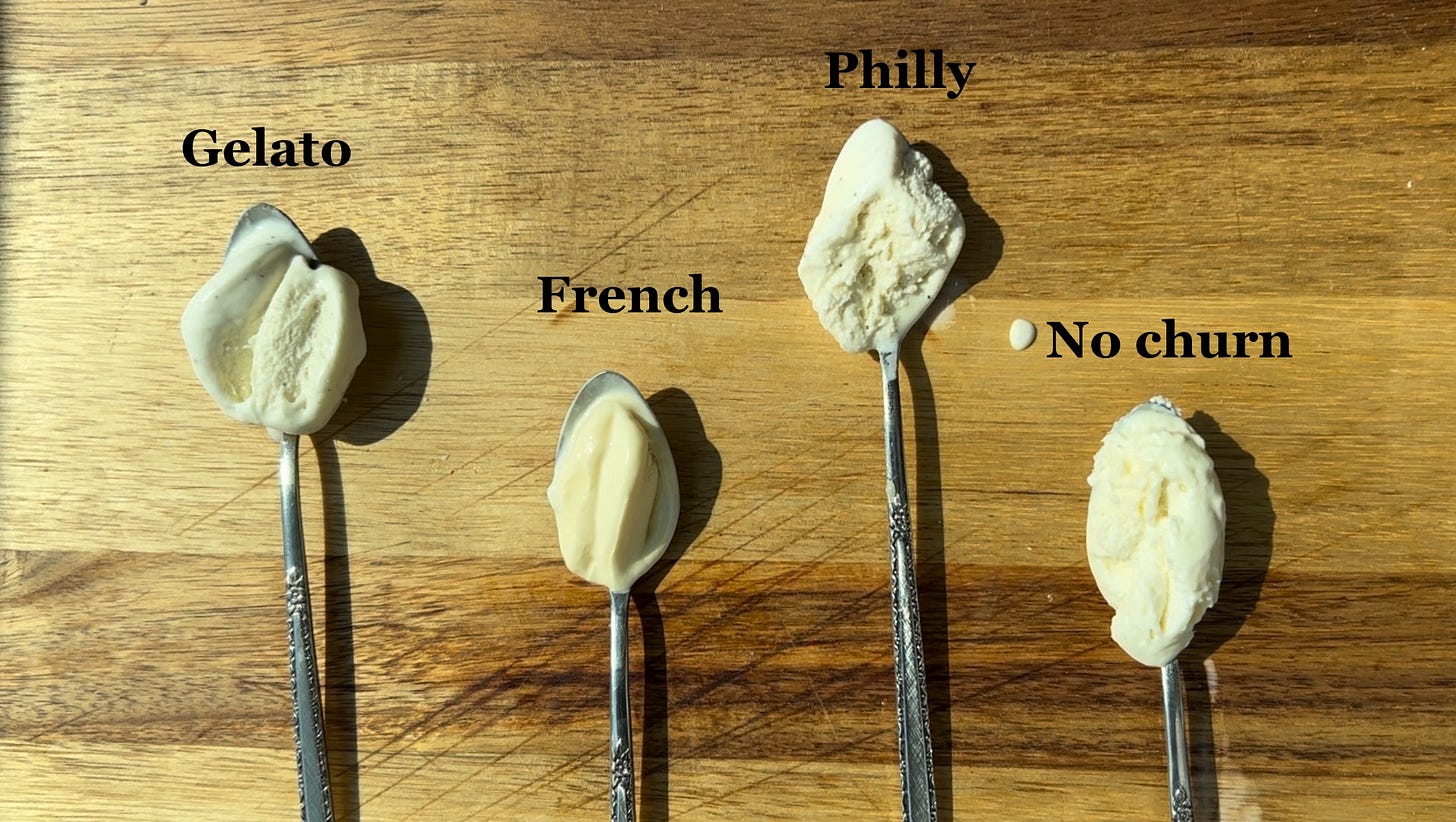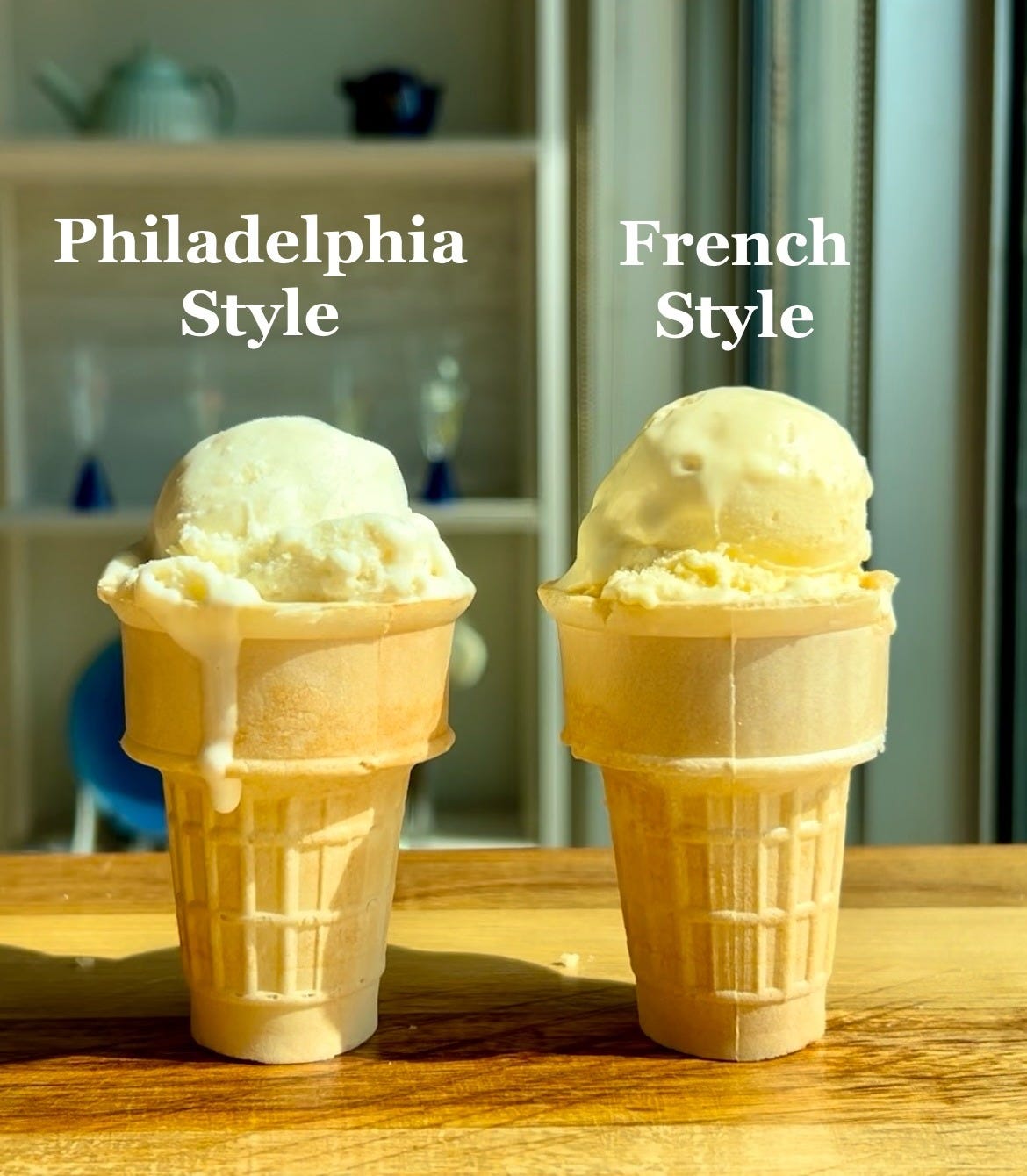The 4 Types of Ice Cream And Why They Taste So Different
Ice cream is the dessert of summer—at least in my opinion.
Nothing beats the heat like a cold, creamy scoop of custard. It may seem simple, but ice cream can vary wildly in taste and texture depending on how it's made. And since it’s peak heat and humidity (at least where I live) season, this month’s newsletter is diving into the science of ice cream.
Whether you love a silky French custard or a quick-and-easy no-churn, there’s a world of chemistry hiding in every frozen bite. Today we’re breaking down the molecular magic behind four popular styles: Philadelphia-style, French custard, gelato, and no-churn.
We’ll explore what each type really is, how their formulas and methods shape texture and flavor, and what’s happening on a microscopic level—from fat globules and emulsifiers to ice crystals and overrun.
1. Philadelphia-Style Ice Cream
Philadelphia-style ice cream is made without eggs, so it relies on a basic emulsion of milk fat and water, stabilized by milk proteins (and sometimes added gums). Because it skips the yolks, it’s not quite as creamy, but it’s clean, quick, and bright.
What that means for texture:
Larger ice crystals (unless churned efficiently)
Less stable foam over time
A clean, fresh flavor with a slightly icier finish
Base: Milk + cream + sugar (no eggs)
Key Features: Clean dairy flavor, lighter body, fast prep
Science spotlight:
Milk proteins like caseins coat fat globules to stabilize the emulsion. But without the help of egg yolks (which contain phospholipids like lecithin), the structure is more delicate and melts faster.
2. French-Style (Custard) Ice Cream
Egg yolks don’t just make the base richer—they also contain emulsifiers and proteins that help bind water and fat, minimize ice crystal growth, and create that signature custard-like texture. Heating the base thickens it, making it more stable and velvety.
What that means for texture:
Smaller ice crystals thanks to yolk emulsifiers
Dense, creamy texture from the cooked custard
Slower melt rate from yolk lecithin
Base: Milk + cream + sugar + egg yolks
Key Features: Rich, dense, silky texture
Science spotlight:
Yolk phospholipids reduce surface tension, making it easier to whip in air and blend fat evenly. Lecithin keeps the emulsion stable, which helps the ice cream stay smooth and creamy.
3. Gelato
Gelato is churned more slowly and contains less air and less fat than ice cream—typically around 4–8% fat. That gives it a dense, elastic texture and a warmer serving temp that brings flavors forward.
What that means for texture:
Slower churning = fewer air pockets
Lower fat = more water, which means a higher risk of ice crystals
Stabilizers and emulsifiers help smooth things out
Base: Milk + sugar (less cream, sometimes eggs)
Key Features: Dense, elastic, intensely flavored
Science spotlight:
Italian gelato often uses thickeners like starch, inulin, or carboxymethylcellulose to cut down on iciness and enhance texture. Getting the right sugar ratios and solids concentration is key.
4. No-Churn Ice Cream
No-churn ice cream skips the ice cream maker entirely. Instead, it uses whipped cream to trap air and sweetened condensed milk for body and stability. It’s quick and easy, but the texture depends heavily on your technique.
What that means for texture:
Pre-whipped cream = built-in air
High sugar = lower freezing point
Stable foam from condensed milk proteins
But without churning to break up ice crystals as they form, it can turn icy if not frozen quickly and tends to be on the sweeter side.
Base: Sweetened condensed milk + whipped cream
Key Features: Easy prep, mousse-like texture
Science spotlight:
The stability of this version depends on how well the cream is whipped and how quickly it freezes. Condensed milk brings both sugar and milk solids, which help with structure.
Takeaway Tips
Want creaminess? Egg yolks and slow churning are your best friends.
Want bold flavor? Gelato and no-churn versions melt faster and feel warmer on your tongue, which amps up flavor.
Want simple? Philadelphia-style is clean-tasting and quick to make.
Sources:
Goff, H.D. (2008). Colloidal aspects of ice cream. Food Hydrocolloids
Goff, H.D. & Hartel, R.W. (2013). Ice Cream: Chemistry, Physics, and Microbiology
Gagliardi, F. et al. (2019). Stabilizers in Italian-style gelato. Current Research in Food Science
Roland, A.M. et al. (2017). Journal of Dairy Science
Want to learn more? Have a questions? Reply and let me know—I always love talking about the science behind baking.
Stay Sweet,
Sarah @HalfBatchBaking




This is so precise to the point yet generously insightful!
Your work is perfect for a beginner who wants to expand knowledge - I have learnt a lot from your work
Thank you for this!